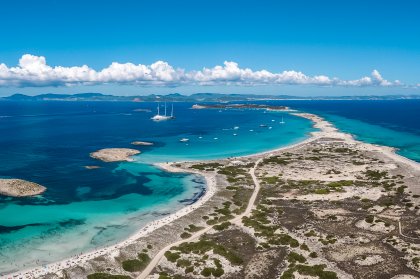Ses Salines de Formentera is a nature park which has been declared an item of World Heritage by the UNESCO (United Nations Educational, Scientific and Cultural
Organisation).
Situated between the south coast of Ibiza and northern Formentera, it homes the oldest, largest living being on the planet…a 100,000 year-old posidonia, measuring
8 kilometres across and growing at a rate of 1 metre every hundred years. The longevity and growth of the posidonia is due to the fact that it is located in the very place on the planet that
receives the largest amount of biophotons from the sun. This has meant that over the last 100,000 years, it has spread across the sea bed, dramatically increasing the amount of oxygen and natural
filters in the ocean, and leaving it purer and more crystalline than anywhere else in the world. It is these waters that feed the magnificent salt pans of Ses Salines de Formentera.

Formentera has a long history of salt production, dating back to the Phoenicians in the seventh century, for whom the extraction of salt was the primary activity and essential for
the economy. The salt pans, situated near La Savina are in the perfect location for the production of salt; it is flat, one metre above sea level and with sun almost all the year long to help
evaporate the water. Sea water floods the shallow lagoons, then evaporates when heated by the sun, resulting in pure salt being left behind. Formentera's salt pans have not been in commercial use
since 1984, but crystallisation in the pools continues nonetheless and creates an environment on which salt-loving flora and fauna thrive.

The wetland, with its fragile dune system, is an Area of Special Protection for Birds and migrating birds use the area as a resting point. There are 210 catalogued species in total, including
herons and flamingoes. Many small animals also find shelter here, amongst which the "Akis Bremeri" cockroach is completely unique to this area of Formentera and not to be found anywhere else on the
planet.
The landscape around Ses Salines de Formentera is breath-taking and other-worldy, with its salt-white mountains, making it very popular with tourists especially towards the end of
summer when the microorganisms in the salt pans make them take on a pinkish hue. The best time to visit is at sunrise or sunset to make the most of the magnificent display of colours created.

Nowadays, salt still plays a major role on Formentera and the company Ses Salines de Formentera recently started producing a natural liquid salt which is prepared at the island's salt flats.
According to the creators, this salt contains ten times the highest concentration of minerals and elements than all other natural salts, and the lowest sodium content of all the salt produced in
Spain. With no colour or taste additives, it is claimed that this is ideal for a cardio-healthy diet.
